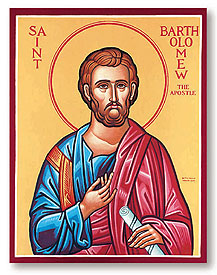Our Patron

In the annals of Christendom, Saint Bartholomew holds a very special place as one of Jesus’ twelve chosen Apostles, but the details of his life are largely shrouded in mystery. He is mentioned by name in the Gospels of Matthew, Mark and Luke, and is always found to be in the presence of the Apostle Philip. In the Gospel of John, Bartholomew is not mentioned by name, but Nathanael is listed as a companion of Philip, suggesting that Bartholomew and Nathanael might be different names for the same person.
The three Synoptic Gospels record no special words or deeds attributed to Bartholomew, but John’s Gospel records Nathanael (Bartholomew?) as voicing skepticism that the Messiah could come from Nazareth – before coming to acknowledge Jesus as both the Son of God and King of Israel. And it is believed that he was present when Jesus appeared to several Apostles at the Sea of Galilee after His Resurrection.
Several early Church leaders and ecclesiastical historians have associated Bartholomew with missionary journeys into such diverse localities as India, Ethiopia, Mesopotamia, Parthia and Armenia. He is reputed to have been martyred in what is now southeastern Turkey while ministering to the Armenians. Tradition holds that he was flayed alive and then crucified upside down for his refusal to worship the local pagan gods,
The Roman Catholic Church celebrates the feast of St, Bartholomew on August 24th, while the Eastern Orthodox churches honor him on June 11th. He is recognized as the patron of bookbinders, plasterers, butchers, tanners and shoemakers, and is the patron saint of Armenia, where a thirteenth century monastery bears his name.